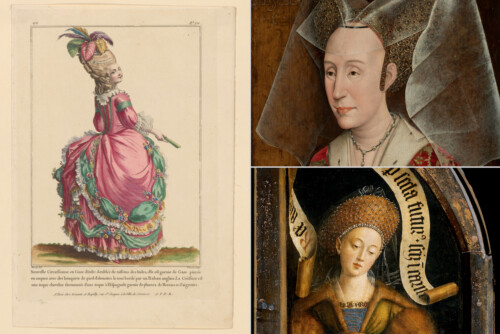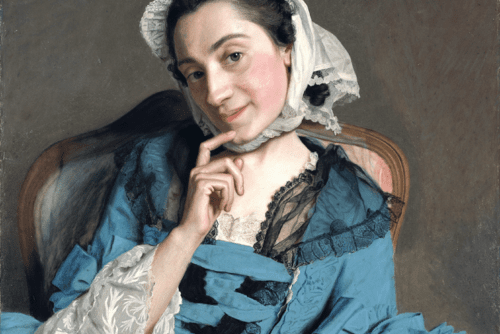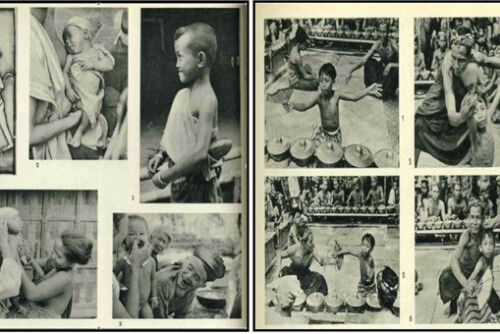Isabel’s relationship to textual networks of women writers, readers, and patrons is not the only factor that makes the notion of an implied community of women, outside of households and monastic orders, pertinent to understanding her life and role. Visual culture also provides such clues, in particular the devotional markers of Isabel’s pictorial representation with Saint Elizabeth of Thuringia – her patron saint, since the names Isabel and Elizabeth were then interchangeable. 1 One such depiction is a foundation plaque at the Chartreuse of Petit-Bâle, which shows Isabel and Philip kneeling on each side of a Pietà with their son Charles, Saint Elizabeth to Isabel’s right, and Philip with Saint Andrew who stands with his cross. 2 In the five-panel Coronation of the Virgin in the Treasury of the Arras cathedral, that scene is repeated, but the duke and duchess are represented separately and without their children, at the farthest wings of the work (that is, in panels one and five), each with their respective saint. In this rendition, Isabel wears a close-fitting, veil-like head covering and a monastically sober Burgundian cloak. 3 Saint Elizabeth also appears at the foot of the reliquary Isabel offered to the ducal chapel of Dijon in 1454 to hold the miraculous host given to the duke by Pope Eugene IV. 4 It is the 1470s donor panel by Petrus Christus (see figure 1), 5 however, that raises some of the most interesting possibilities. Isabel is alone with the saint who presents Isabel with one hand while she holds the crowns emblematic of her three levels of attained virginity with her other. Isabel is not pictured as a monastic and self-effacing figure. Instead, her brocade gown signals her high status and Burgundian wealth. Her headdress, instead of the regal apparatus of translucent silk over massive jeweled side pieces that she wears in her official portrait as the Persian Sybil in the Getty museum (figure 2), 6 codes modesty and piety with starched white wings lightly poised on the side pieces. Her modesty and piety are framed very differently than, for instance, they are in her portrayal as the Erythrean Sybil in the Ghent altarpiece, where her pose, hand pointing to womb and ears wide open to receive the divine message, modeled on the Annunciation, reflects male hierarchy in a celebration of the birth of a ducal heir (figure 3). 7 A close look at the Petrus Christus portrayal brings out two other features. First, the saint and donor are located in a sparse, austere building that appears to be part of a convent complex, but windows and doors are wide open, suggesting that no enclosure is enforced and that access to the wider world is maintained. Second, Isabel’s gown is unusual, and not found in her other portraits: rather than a brocade covered with a foliate design, it is all black with borders and highlights of gold paisley that resemble a Persian design. The robe’s black background echoes the stark black dress of the saint, and the gold patterns echo the saint’s gold crowns. 8
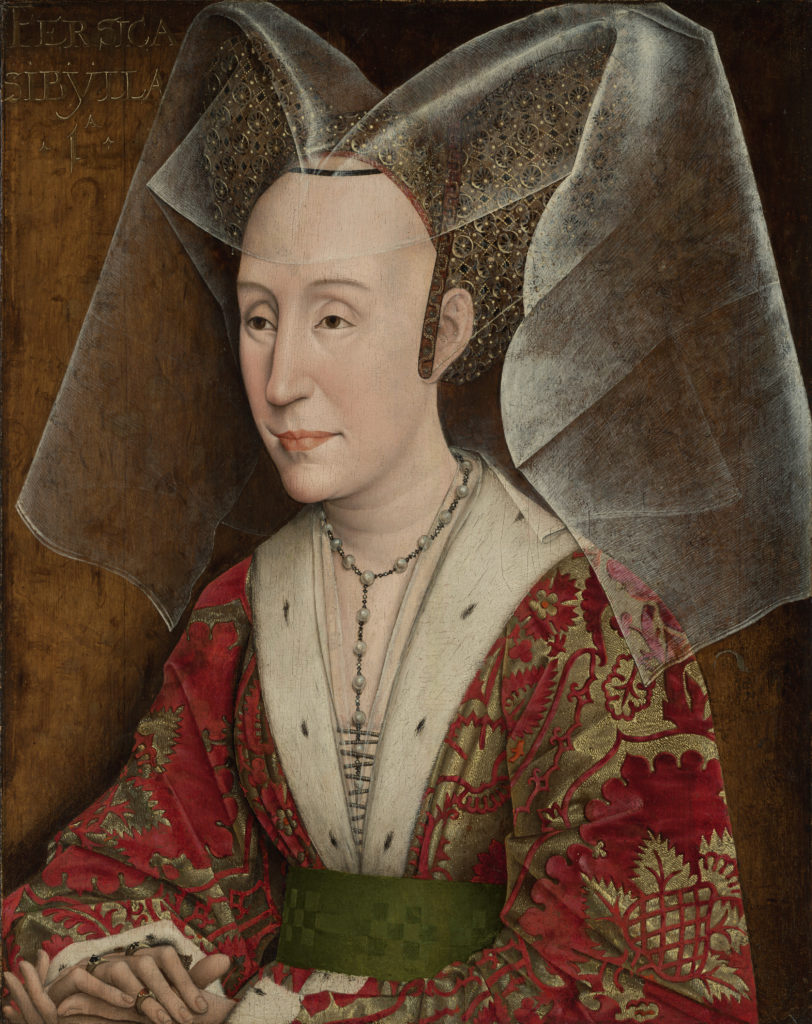
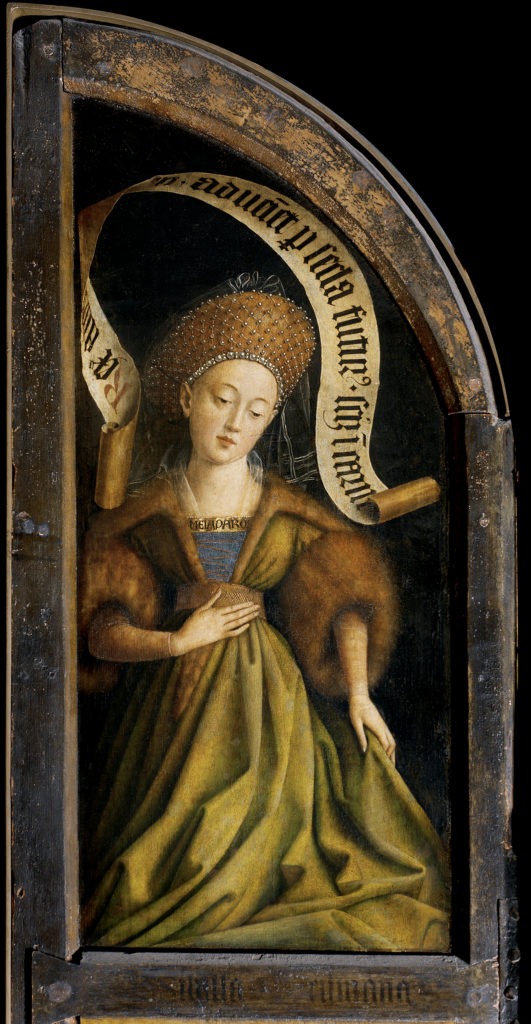
Andrea Pearson’s choice of the phrase “women’s viewing communities” as a productive way to interpret women’s relationship to the arts operates usefully on different levels, from pictorial representations that “could sustain strong notions of womanhood for female spectators” to instances where women share viewing through gifts of images to each other. 9 It is tempting to combine such a “viewing” model with Susan Conklin Akbari’s analysis of how a secular community shapes itself by seeking to transform the nation’s sense of constant mutability into a form of immutability modeled on the sacred and expressed through a deep understanding of the hidden virtus (power, strength, or excellence) of things. 10 Such models may illuminate how the symbolic and affective power of the donor portrait melds with inchoate but insistent yearnings for community. Indeed, donor images combine an act of piety with the display of secular wealth and power. At the same time, the potentially excessive secularity of that display is transcended by the close proximity to a saint and the intimacy of the presentation gesture. Through canonization, the saint sheds the impermanence and sinful frailty of human life, transforming even recognizable material trappings such as robes or, in Elizabeth’s case, crowns into complex codes that the viewer must decipher. In the visually striking proximity of the human donor to the sacred, the femaleness of the donor-saint pair contrasts the belittled status of women in their society, starker yet when that female patron saint is at once widely revered in the region where the donor exercises some authority and evokes by her mere presence a complex nexus of communal associations and messages specifically aimed at women, as was the case with Saint Elizabeth.
Several considerations indicate that portraits of Isabel with Saint Elizabeth, if contemporary to Isabel, belong to the pictorial record of an allusive reading and viewing community of women, even without other women present, whether in the images themselves or in private viewings and even though they were painted by men, who would have secured Isabel’s approval given the implications for her public identity. First is the fact that Elizabeth, canonized four years after her death, 11 was a compelling presence in the southern Low Countries and in French territories nearby, with large numbers of the béguinages that preserved their original independence and structure under her patronage. She was the third most popular patron saint after the Virgin Mary and Saint Catherine. The Low Countries had long-standing ties with the Marburg center of the Elizabeth cult, and Elizabeth’s daughter Sophia married Duke Henry II of Brabant in 1240. The beguines’ balancing of vita active and vita contemplativa, caring for the sick and poor and doing textile work, mirrored the life of the saint, defined by an active form of charity in close contact with the poor and who most clearly embodied the early Franciscan ideals. 12 As early as 1239, Countess Joan of Flanders founded a hospital dedicated to Saint Elizabeth and the Virgin Mary in Lille and supported one in Valenciennes. Joan was also the main benefactor of the Wijngaard in Bruges and of the Groot Begijnhof in Ghent, both of which were dedicated to Saint Elizabeth by 1242. Countess Margaret, her sister, was the first major supporter of the Saint Elizabeth béguinage in Lille before 1245 and founded two more in Mons/Bergen and Maubeuge dedicated between 1245 and 1291. 13
Second, whereas Elizabeth was married and had numerous children, like many other women mystics of the time, she eventually rejected biological motherhood, as did Birgitta, to embrace a spiritual motherhood of all in her care and in need of food and solace. 14 What was Isabel’s position on her own role as mother? Isabel lost several children in childbirth – she founded two monastic cells in Champmol in 1432, after the deaths of her first two sons, who are represented kneeling in prayer behind her on several foundation plaques – and she had a close relationship with Charles, her only surviving child. 15 Yet, it can be surmised that, like other noblewomen of her day, she found a special spiritual guidance in the cult of a saint who lived in the not-so-distant past and managed to encompass, transcend, and reconvert her own experience of motherhood in ways that eschewed the contingencies of flesh, illness, and power.
In donor panels, established pictorial principle placed men on the right and women on the left (the object itself is the embodied viewer, thus the right of the human viewer is the left in the symbolic structure). This effect and its conventional basis have been extensively discussed by Corine Schleif, who underscores the creation of a special (potentially negative) space of women in the purported symmetry of an arrangement that is destabilized and made asymmetrical by the socially and theologically enhanced male position. 16 Conversely, the structural binary of the donor portrait imposes a gendered gaze on the viewer, effectively isolating the women, donor and saint, into an unprivileged left-side women-only space, dislocated from the main message. Visually, such donor portraits refer both to the woman’s family status and to her distinct position as a woman in the spiritual donor economy. Depicted frequently with her patron saint Elizabeth of Thuringia, Isabel is symbolically reintegrated in an elusive and allusive community of women also because the saint’s presence references the active life of charity and self-abnegation so frequently elected by medieval and early modern women as a means of spiritual expression. Furthermore, the saint was not, as was commonly asserted, a member of the Franciscan tertiaries, but a rare instance of medieval lay sanctity. 17 Referentially, behind the visible donor panel stands the iconology of Elizabeth with her four devout maidens, whose testimony confirmed her saintly character and whose presence she was forced to give up in sacrifice.
Visual culture’s donor genre mirrored Isabel’s links to the communities she helped forge, whereas the textual archive of her written and spoken words endure only in the material records of her managerial functions. Isabel’s extended familial networks, including men and women, were made more intimate and cemented by ties to women kin, and were reflected over generations through the continuation of specific women’s devotional commitments. Thus, an invisible yet implied community was woven among the women whose lives she touched. Isabel exercised the traditional forms of patronage of aristocratic women, and was active in public affairs, influencing and training other women in how to negotiate the avenues of power, even during her retreat from marriage and court. Yet, it is perhaps in her isolated representation in the left wing of the donor portrait, where she kneels in front of her patron saint, that an expression of and yearning for community among women steeped in the spirituality of the devotio moderna takes its most vivid shape.
- On the significance of Isabel’s name, see Lori J. Walters, “The Queen’s Manuscript (London, British Library, Harley 4431) as a Monument to Peace,” Le Moyen Français 75 (2014): 85–120, at 107–09. [↑]
- Basle Historisches Museum, inv. 1870.673; reproduced in Lemaire and Henry, Isabelle de Portugal, 171, plate 35.[↑]
- Arras, Treasure of the Cathedral; reproduced in Lemaire and Henry, Isabelle de Portugal, 181, plate 45. For the two contrasting trends in the representation of the duchess – in sartorial splendor or monastic garb – see Jane Friedman, “A New Look at the Imagery of Isabelle of Portugal,” Notes in the History of Art 1, no. 4 (Summer 1982): 9–12.[↑]
- Sommé, Femme au pouvoir, 453.[↑]
- Christus, Petrus, ca. 1410–1472. Benefactress (Isabella of Portugal) w/St. Elizabeth. 1472–73. Repository: Bruges, Groeningemuseum, inv D O GRO 1614.1, left panel of triptych.[↑]
- Lorne Campbell and Yvonne Szafran, “The Portrait of Isabella of Portugal, Duchess of Burgundy, in the J. Paul Getty Museum,” Burlington Magazine 146, no. 1212 (March 2004): 48–157, http://www.jstor.org/stable/20073437.[↑]
- Penny Howell Jolly, “More on the Van Eyck Question: Philip the Good of Burgundy, Isabelle of Portugal, and the Ghent Altarpiece,” Oud Holland Jaargang 101, no. 4 (1987): 237–53, 246–7.[↑]
- A model for this connection through sartorial detail in the portrait is found in Pearson’s close study of the imagery in folio 14v of the Hours of Mary of Burgundy: she shows how the genealogy of reading and gifting knowledge between Mary and Margaret of York is emphasized through the fabric echoes in their dress and a brocade book bag. Envisioning Gender, 53–8.[↑]
- Pearson underlines the empowering potential for other women of images “of women shown operating outside of patriarchal controls and gender stereotypes,” whether images of “holy women as readers and educators” or “portraits of laywomen in empowered situations [that] could also function in an exemplary way for other female viewers.” Envisioning Gender, 51.[↑]
- The essay by Susan Conklin Akbari, “Death as Metamorphosis in the Devotional and Political Allegory of Christine de Pizan,” in The Ends of the Body: Identity and Community in Medieval Culture, eds. Suzanne Conklin Akbari and Jill Ross (Toronto: University of Toronto Press, 2013), 283–313, pertains to the workings of a polysemous vertu or virtus in the work of Christine de Pizan on the body politic and its relation to the formulation of community, but has interesting implications regarding the formulation of an allusive community of women.[↑]
- André Vauchez’s table of lay persons who were the object of a canonization process between 1198 and 1431 places Elizabeth among the few who were canonized a few years after their death. Vauchez, La sainteté en Occident aux derniers siècles du Moyen Age: D’après les procès de canonisation et les documents hagiographiques (Rome: Ecole française de Rome, 1988), 311. “Virtus” here designates the power, excellence, or strength of things.[↑]
- Vauchez, La sainteté, 434–5.[↑]
- Gecser, Feast and Pulpit, 43–4.[↑]
- Barbara Newman, From Virile Woman to Woman Christ: Studies in Medieval Religion and Literature (Philadelphia: University of Pennsylvania Press, 1995), 86–7, 94. [↑]
- Discussion of foundations that reference her first two sons in Sommé, Femme au pouvoir, 464–5; reproductions of plaques in Lemaire and Henry, 171, 172; on her relationship with Charles, Sommé, “Une mère et son fils.”[↑]
- Corine Schleif, “Men on the Right – Women on the Left: (A)Symmetrical Spaces and Gendered Spaces,” in Women’s Space: Patronage, Place, and Gender in the Medieval Church, eds. Virginia Cieffo Raguin and Sarah Stanbury (Albany, NY: State University of New York Press, 2005), 207–40.[↑]
- Vauchez, La sainteté, 447.[↑]
